Fluids
A fluid is a substance that can flow when external force is applied on it. The term fluids include both liquids and gases. Though liquids and gases are termed as fluids, there are marked differences between them. For example, gases are compressible whereas liquids are nearly incompressible. We only use those properties of liquids and gases, which are linked with their ability to flow, while discussing the mechanics of fluids.
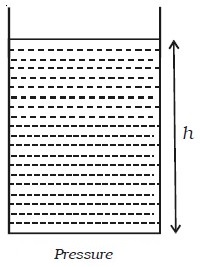
Pressure due to a liquid column
Let h be the height of the liquid column in a cylinder of cross sectional area A. If ρ is the density of the liquid, then weight of the liquid column W is given by
W = mass of liquid column × g = Ahρg
By definition, pressure is the force acting per unit area.
∴ Pressure = weight of liquid column/area of cross − section
= Ahρg/A= hρg
∴ P = hρg
Pascal’s law
One of the most important facts about fluid pressure is that a change in pressure at one part of the liquid will be transmitted without any change to other parts. This was put forward by Blaise Pascal (1623 – 1662), a French mathematician and physicist. This rule is known as Pascal’s law.
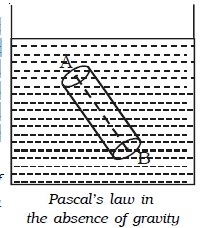
Pascal’s law states that if the effect of gravity can be neglected then the pressure in a fluid in equilibrium is the same everywhere. Consider any two points A and B inside the fluid. Imagine a cylinder such that points A and B lie at the centre of the circular surfaces at the top and bottom of the cylinder (Fig. above). Let the fluid inside this cylinder be in equilibrium under the action of forces from outside the fluid. These forces act everywhere perpendicular to the surface of the cylinder. The forces acting on the circular, top and bottom surfaces are perpendicular to the forces acting on the cylindrical surface. Therefore the forces acting on the faces at A and B are equal and opposite and hence add to zero. As the areas of these two faces are equal, we can conclude that pressure at A is equal to pressure at B. This is the proof of Pascal’s law when the effect of gravity is not taken into account.
Pascal’s law and effect of gravity
When gravity is taken into account, Pascal’s law is to be modified. Consider a cylindrical liquid column of height h and density ρ in a vessel as shown in the Fig. below.
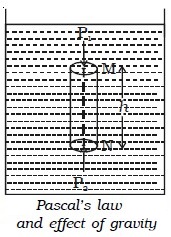
If the effect of gravity is neglected, then pressure at M will be equal to pressure at N. But, if force due to gravity is taken into account, then they are not equal.
As the liquid column is in equilibrium, the forces acting on it are balanced. The vertical forces acting are
● Force P1A acting vertically down on the top surface.
● Weight mg of the liquid column acting vertically downwards.
● Force P2A at the bottom surface acting vertically upwards.
where P1 and P2 are the pressures at the top and bottom faces, A is the area of cross section of the circular face and m is the mass of the cylindrical liquid column.

This equation proves that the pressure is the same at all points at the same depth. This results in another statement of Pascal’s law which can be stated as change in pressure at any point in an enclosed fluid at rest is transmitted undiminished to all points in the fluid and act in all directions.
Applications of Pascal’s law
Hydraulic lift
An important application of Pascal’s law is the hydraulic lift used to lift heavy objects. A schematic diagram of a hydraulic lift is shown in the Fig. below. It consists of a liquid container which has pistons fitted into the small and large opening cylinders. If a1 and a2 are the areas of the pistons A and B respectively, F is the force applied on A and W is the load on B, then
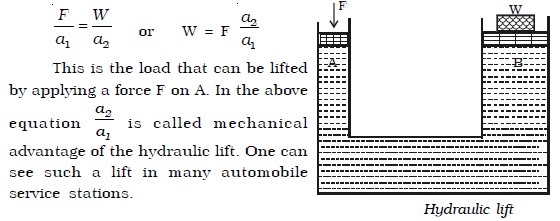
Hydraulic brake
When brakes are applied suddenly in a moving vehicle, there is every chance of the vehicle to skid because the wheels are not retarded uniformly. In order to avoid this danger of skidding when the brakes are applied, the brake mechanism must be such that each wheel is equally and simultaneously retarded. A hydraulic brake serves this purpose. It works on the principle of Pascal’s law. Fig. below shows the schematic diagram of a hydraulic brake system. The brake system has a main cylinder filled with brake oil. The main cylinder is provided with a piston P which is connected to the brake
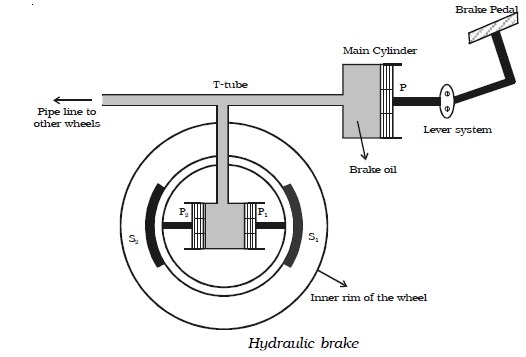
pedal through a lever assembly. A T shaped tube is provided at the other end of the main cylinder. The wheel cylinder having two pistons P1 and P2 is connected to the T tube. The pistons P1 and P2 are connected to the brake shoes S1 and S2 respectively. When the brake pedal is pressed, piston P is pushed due to the lever assembly operation. The pressure in the main cylinder is transmitted to P1 and P2. The pistons P1 and P2 push the brake shoes away, which in turn press against the inner rim of the wheel. Thus the motion of the wheel is arrested. The area of the pistons P1 and P2 is greater than that of P. Therefore a small force applied to the brake pedal produces a large thrust on the wheel rim. The main cylinder is connected to all the wheels of the automobile through pipe line for applying equal pressure to all the wheels .

